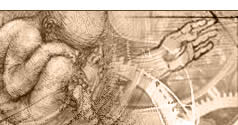 |
 |
 |
 |
 |
 |
 |
 |
|
 |
 |
 |
32 Vivum ex vivo
|
| Menu | back |
Vivum ex vivo Life comes only [sic] from life. This statement formulated by Louis Pasteur still complies fully even today with all data obtained experimentally from inanimate, prebiotic nature. At the time of Darwin, it was still believed that life could develop spontaneously in/through waste or rotting garbage. This development was called abiogenesis. Louis Pasteur was the first to prove that bacteria cannot originate on its own.
On April 1, 1864, at the Sorbonne in Paris, Louis Pasteur proved before a large group of scientists that abiogenesis does not function. Pasteur, who rejected Darwins theory of the origin of the species concluded that life can only evolve from life. Nevertheless, today many scientists still believe that several billion years ago on the primordial Earth, abiogenesis could possibly have resulted in so-called simple forms of life (1).
It is helpful to remember that even the simplest protozoa are comparable with a personal computer in terms of their complexity. Hundreds of mechanisms and hundreds of thousands of correct links are required for a cell to live. The failure of even one single mechanism (or its absence in a fully functional form from the beginning) results in the death of the cell or in it not being capable of living from the very beginning.
Nobel Prize winner Francis Crick saw the obvious impossibility of life evolving by chance. As an atheist and evolutionist, however, he did not want to accept a creator as the originator of life and therefore espoused the theory that life on Earth originated from extraterrestrial sources. However, this does not solve the problem; it simply shifts it into space.
Renowned evolutionist and senior writer of Scientific American John Horgan wrote the following: "If I were a creationist, I would cease attacking the theory of evolution which is so well supported by the fossil record and focus instead on the origin of life. This is by far the weakest strut of the chassis of modern biology. The origin of life is a science writer's dream. It abounds with exotic scientists and exotic theories, which are never entirely abandoned or accepted, but merely go in and out of fashion"(2).
At a presentation in CERN near Geneva (17 Nov. 1965) the biochemist Ernest Kahane stated: "It is absurd and absolutely nonsense to believe that a living cell developed all by itself; nevertheless, I do believe it, because I cannot imagine any alternative.
These 33 | Menu |
back
|
References:
|
| (1) |
Bruno Vollmert, Das Molekül und das Leben, Rowohlt, 1985, Der Urey-Miller-Versuch: Ursuppen, pages 3945. |
| (2) |
John Horgan, The End of Science: Facing the Limits of Knowledge in the Twilight of the Scientific Age, Little, Brown & Co, London, 1997, page 138. | |
| |
Comment this Site!
|
 |
 |
 |
 |
|

